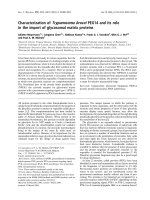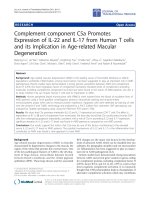Cycocel induced lignin deposition in cotton cells and its role in crop growth
Bạn đang xem bản rút gọn của tài liệu. Xem và tải ngay bản đầy đủ của tài liệu tại đây (778.71 KB, 7 trang )
Int.J.Curr.Microbiol.App.Sci (2019) 8(3): 1567-1573
International Journal of Current Microbiology and Applied Sciences
ISSN: 2319-7706 Volume 8 Number 03 (2019)
Journal homepage:
Original Research Article
/>
Cycocel Induced Lignin Deposition in Cotton Cells and
its Role in Crop Growth
Santosh Kumari1* and Vipin Kumar Verma2
1
2
Division of Plant physiology, Indian Agricultural Research Institute, Delhi, India
Department of Pharmacology, All India Institute of Medical Sciences, New Delhi, India
*Corresponding author
ABSTRACT
Keywords
Anatomy, Cotton,
Cycocel, Growth,
Lignin, Root, Stem
Article Info
Accepted:
12 February 2019
Available Online:
10 March 2019
Cycocel reduced internode length accompanied with increased stem, root
and leaf thickness. Cycocel remarkably added cells to phloem fiber, xylem
fiber and xylem vessels in stem and root of treated plants. S-lignin, Glignin and H-lignin were noticed in retardant treated suppressed stem tissue
of cotton.
Introduction
Cotton is grown for textile fiber and oil for
food. Cotton sticks are used as fuel and seed
cover as cake for animal feed. The potential
as a feedstock for paper production and
biofuels generate interest in the composition
of cotton plant. The lignin deposition is
generally associated with secondary cell walls
of xylem vessels and fibers in angiosperm
provide mechanical support and protect
against biotic and abiotic stresses. Cotton may
prove a useful system for the study of the
control of lignin quality and quantity by plant
growth regulators. The study was carried out
to understand Cycocel induced lignin
deposition in cotton cells and its role in crop
growth. How does cycocel affect growth and
development of cotton plant in commercial
production for more efficiency and
profitability along with nutrient management?
Materials and Methods
Five seeds of cotton were grown in earthen
pots filled with 12 kg field soil mixed with
manure in pot house under natural
environment on 20th May and 20th June 2017.
One plant was maintained in each pot after
thinning in first sowing and two plants in
second sowing to confirm the results. Cycocel
treatment was given as 1ml/liter water as
1567
Int.J.Curr.Microbiol.App.Sci (2019) 8(3): 1567-1573
foliar spray once on whole plant surface at 78 leaves stage on 35th day after sowing in each
sowing. 1g urea per/pot and 1g potash per pot
was applied along with irrigation water for
treatment of nitrogen (N) and potassium (K).
Anatomical observations were made at first
square formation stage in control as well as
cycocel treated plants.
Fresh samples of root, stem and leaves from
control and cycocel treated plants were used
for light microscopy (Nikon, Tokyo, Japan)
transverse sections were cut by hand and
stained in saffranin dissolved in water). These
plants were used for photographic data of root
length and plant height, compactness and
branching patterns. Anatomical data from
stem and root has been analysed for lignin
deposition.
Results and Discussion
Cycocel treated plants showed the symptoms
of leaf senescence, dropping leaves, stomatal
closure and cessation of transpiration for a
week (Fig. 1A, B and J), new leaves
originated from the nodes bearing older
leaves that wilted, dried and shed after
mobilization of their metabolites. Crop
growth, dry matter accumulation and
productivity are influenced by photosynthetic
efficiency and total leaf area. Our result
indicated that Cycocel retarded growth may
be tailored with micronutrient doses in the
management of crop growth stages in cotton
production system. Potassium (K) is one of
the essential micronutrient required for
normal plant growth and development. K
affects water relations and osmotic
adjustment,
cell
elongation,
stomatal
conductance, photosynthesis, solute transport,
protein synthesis and acts as a cofactor for a
number of metabolic enzymes (Mengel and
Kirby, 2001; Marschner, 2012). Present study
showed that K affected the metabolic
processes and reversed the retardant effect to
some extent on internode elongation, root
elongation and production of reproductive
organ i.e. flower/boll formation as strong
metabolic sink (Fig. 1F). Potassium affected
turgor pressure and orientation of leaf in
regenerated stem of cycocel treated plants, the
emerging leaves showed the turgor mediated
downward folding of leaf lobes (Fig. 1M)
towards each other like closing umbrella
during evening and opening of lobes in the
day light. Same amount of nitrogen (N)
application extended vegetative growth as leaf
area formation and root elongation three times
that of control (Fig. 1E) subsequently led to
delay in reproductive growth i.e. formation of
square, flower and bolls.
Cycocel treated cotton plant survived for one
month under water logged conditions and
survived 15 days more than control plants
hence proved effective under excess water
stress. Our photography and visual
observation revealed that new leaves
formation by shedding old ones sprayed with
cycocel prolonged the survival of plant (Fig.
1K & L). Our observation suggest that new
lateral roots emerged from the lenticels close
to the root shoot junction when tip of the
primary root was cut and shoot was immersed
in tap water along with mature control plant at
reproductive stage i.e. flower formation in
both plants and without main root tip;
cytokinin transported from the roots to the
stem helped in shoot formation by new leaves
emergence from the apical meristem and
dormant older nodes devoid of leaves i.e.
shedding. Intermodal length of newly formed
shoot inherited the cycocel effect and apical
dominance was displayed by the growing
stem tip producing only leaves reverting to
vegetative growth from reproductive phase
(one flower was produced) when the shoot
was immersed into water. The leaves
emerging at older nodes and branches were
three lobed and smaller in size indicating
remobilization of assimilates (limited) from
1568
Int.J.Curr.Microbiol.App.Sci (2019) 8(3): 1567-1573
roots and stem to the new organs. A leaf
formed at the lateral branch terminal was
generally simple lamina without any lobe.
Subsequently formed leaves from the new
stem nodes were bigger in size with five
lobes. Number of lobes in leaf lamina
decreased towards the stem apex again
indicating limited nutrients. When potassium
was supplied at the emerging three lobed leaf
stages stipule formation occurs at the base of
this and all newly formed leaves; the
particular leaf lamina was enlarged in size
showing interveinal yellowing. Newly formed
leaves had round tip enlarged leaf lobes
showing nyctinastic movements opening in
horizontal direction in light and sleeping in
vertical downward position/ closing the stem
apex in the darkness. These leaves followed
circadian rhythm which is controlled by the
biological clock of these plants. A number of
metabolic pathways are regulated by the
circadian clock. Node number increased with
heavy nitrogen while height increased with
heavy irrigation i.e. turgor maintenance.
Potassium uptake by root cell plasma
membrane transporters have been shown to
improve cell turgor under osmotic stress.
Osmotic adjustment is a key trait for
maintenance of favorable water status,
cellular turgor potential and water retention
and is positively correlated with drought
tolerance. Potassium was shown to improve
stomatal
conductance,
water
status,
photosynthetic rate, quantum yield of PSII,
higher antioxidant enzyme activities and
increased proline accumulation under water
stress in cotton leaves (Zahoor et al., 2017).
Sucrose is an osmolyte that replaces K+ in the
guard cells and open stomata during middle of
the day. It is generally accepted that most of
the sugar is derived from mesophyll cells. As
sucrose accumulates in the apoplast, its
osmotic effect drives water efflux from guard
cells decreasing stomatal aperture and
inversely coordinating photosynthesis and
transpiration (Talbott and Zeiger, 1996; Lu et
al., 1997).
Our anatomical analysis revealed that
suppression of internode length extended the
stem and root diameter. Lignin contents that
were genetically programmed for normal
internode length were distributed as increased
lignin synthesis in increased number of cells
in xylem fiber, phloem fiber and pith cells
(Fig. 2 and 3) Three types of lignin color were
observed in xylem vessels (G-lignin), phloem
cells (S-lignin) and pith cells (H-lignin) in
cycocel treated stem tissues. Small amount of
H-lignin (Xu et al., 2011) and S and G-lignin
have been reported by Macmillan et al.,
(2013) in stem tissue of cotton. H-lignin was
missing in stem sections of control plants.
Number of cell layers was significantly
reduced in xylem fibers and xylem vessel
diameter was affected. The presence of lignin
in stem cells in control plants and additional
lignin in stem tissue bearing heavy leaves on
compact stem with bushy appearance and
absence of lignin in white cotton fiber packed
in strong compact locules of cotton bolls
clearly signifies the role of lignin in
mechanical
support
under
diverse
environments. This study further reveals the
role of growth retardant in secondary
metabolism that indicates plant underwent a
kind of stress and survival strategy adopted by
plants by increasing root diameter and storage
of assimilates under a combination of various
stresses (high temperature, light and water
stress). A critical role for lignin has been
deduced in cotton disease resistance and rapid
accumulation of flavonoids a phenyl
propanoid product suggested their role as
signal molecules (Xu et al., 2011). Cambial
activity could be increased by shift in the
hormone levels especially cytokinin (Ismaeil,
1995) that could have increased the
translocation of N, P, K and photosynthates to
the growing organs of the plant (Marschner,
2012) (Fig. 4).
1569
Int.J.Curr.Microbiol.App.Sci (2019) 8(3): 1567-1573
1570
Int.J.Curr.Microbiol.App.Sci (2019) 8(3): 1567-1573
A
A
B
B
Exodermis
Cortex
Xylem fiber
Phloem
Xylem vessel
Control
Phloem fiber
Cycocel + Urea
Secretory
ducts
C
Medullary
Ray
D
c
Cycocel
Cycocel +Potassium
Fig 2. Stem anatomy displaying xylem fibers and
xylem vessels sizes and distribution under various
treatments in cotton
Control
Cycocel
Root anatomy displaying increased diameter by phloem fiber or
bast formation in CCC treated plants (B)
S-lignin
G-lignin
Fig 3. Lignin distribution in transverse section of cotton stem from control
1571
Int.J.Curr.Microbiol.App.Sci (2019) 8(3): 1567-1573
A
Xylem
B
Cortex
Epidermis
Fig 4. Potassium increased cell size/volume/turgor of node bearing leaves showing rhythmic movement with light in
retardant treated plants applied during regenerating apex in cycocel treated plant (A) control plant (B) died
Lamina thickness and dark green color has
been associated with decorative value and
longevity of leaves in ornamental crops that
bring higher profitability to the growers.
Cytokinin and abscisic acid have been
associated with developmental control of
cambium in sunflower under nitrogen
application and under combination of high
temperature, radiation and water stress in late
sown wheat (Santosh Kumari, 2017 Santosh
Kumari, 2013,Santosh Kumari, 2010). Our
study reveals that cotton crop growth can be
managed by careful application of split doses
of N and K at different stages of internode
elongations under the influence of cycocel to
balance the vegetative (leaf formation) and
reproductive stages (ball formation and
defoliation plus opening of bolls) as
suggested by Santosh Kumari (2009).
Acknowledgement
Help provided in Light microscopy by
Pharmacology Department of AIIMS, Delhi is
thankfully acknowledged.
References
Macmillan CP, Birke H, Bedon F, Pettolino
FA (2013) Lignin Deposition in
Cotton Cells – Where is the lignin? J
Plant Biochem Physiol 1:e106.
doi:10.4172/2329-9029.1000e106
Lu P., Outlaw Jr. W.H., Smith B.G., Freed
G.A. 1997 A new mechanism for the
regulation of stomatal aperture size in
intact leaves:
Accumulation of
mesophyll-derived sucrose in the
guard-cell wall of Vicia faba. Plant
Physiol 114: 109-118
Mengel K., Kirkby E.A. 2001. Principles of
Plant Nutrition. (5th ed.) vol. 35.
Kluwer
Academic
Publishers,
Dordrecht, The Netherlands, pp. 11591160.
Marschner P. 2012 Marschner’s Mineral
Nutrition of Higher Plants. Elsevier
Ltd. Amsterdam, p. 651.
Santosh Kumari (2009). Kapas ki kheti mein
potassium ka mahatav. Pusa Surbhi
(Hindi), IARI.
Santosh Kumari (2010). Cellular changes and
their relationship to morphology,
abscisic acid accumulation and yield
in wheat (Triticum aestivum) cultivars
under water stress. American J. Plant
Physiol.5(5), 257-277. ISSN 15574539doi: 10.3923/ajpp.2010.257.277
Santosh Kumari (2017).Effects of nitrogen
levels on anatomy, growth, and
chlorophyll content in sunflower
(helianthus annuus l.) leaves. J. Agric.
1572
Int.J.Curr.Microbiol.App.Sci (2019) 8(3): 1567-1573
Sci. 9(8): 208-219.
Talbott, L.D. and Zeiger, E. (1996) Central
roles for potassium and sucrose in
guard-cell
osmoregulation.
Plant
Physiol. 111, 1051–1057.
Xu L, Zhu L, Tu L, Liu L, Yuan D, et al.
(2011)Lignin metabolism has a central
role in the resistance of cotton to the
wilt fungus Verticillium dahliae as
revealed by RNA-Seq-dependent
transcriptional
analysis
and
histochemistry. J Exp Bot 62: 56075621. doi:10.1093/jxb/err245
Zahoor R., Zhao W., Dong H., et al.(2017).
Potassium improves photosynthetic
tolerance to and recovery from
episodic drought stress in functional
leaves of cotton (Gossypium hirsutum
L.). Pl. Physiol. Biochem. 119:21-32.
How to cite this article:
Santosh Kumari and Vipin Kumar Verma 2019. Cycocel Induced Lignin Deposition in Cotton
Cells and its Role in Crop Growth. Int.J.Curr.Microbiol.App.Sci. 8(03): 1567-1573.
doi: />
1573









